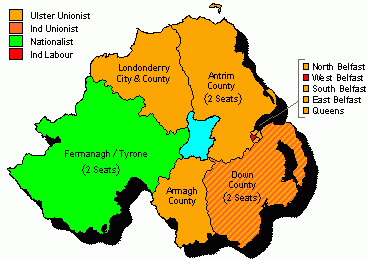

 |

|
| |
|
|
Thursday April 10, 2025
|
The result came as a shock with an unexpected landslide victory for Clement Attlee's Labour Party. A swing of 10.7% to the Labour Party saw the Conservatives reduced to 197 seats, a net loss of 189. Continued divisions between the Liberal and National Liberal factions saw a combined loss of 31 seats including those of both leaders. Labour with 393 seats would go on to form their first majority government.
Northern Ireland emerged from the war years having faced a number of significant challenges. James Craig, leader of the Ulster Unionist Party and the first Prime Minister of Northern Ireland had died in November 1940. His successor, John Andrews, proved an unpopular choice within the party and he was subsequently replaced as by Sir Basil Brooke in April 1943. During the war, conscription had not been extended to Northern Ireland despite the strong support of the Northern Ireland Government. German air-raids in April and May 1941 left almost 1,000 dead and whole districts of Belfast devastated. There had also been intense concern around the British Government’s negotiations with De Valera, offering Unity in exchange for the South’s abandonment of neutrality.
The 1945 Westminster election came less than a month after the Northern Ireland general election. The Unionist Party had seen significant losses and a notable labour surge, with over 120,000 votes going to a fragmented range of left-wing candidates. There was significant concern that this could be repeated in the Westminster contest. In the end, the Unionist Party hegemony was only slightly shaken, with the party returning nine MPs; their lowest tally since the creation of Northern Ireland. The Nationalist Party retained their two seats in Fermanagh and Tyrone and West Belfast fell to Independent Labour candidate Jack Beattie. One of the incumbents for Down, Rev. James Little, was returned as an Independent Unionist, having been first elected in the 1939 by-election under the Ulster Unionist Party banner.

This map by Conal Kelly shows
the winner in each constituency in 1945.
| Party | Votes | % Share | Seats Won | |
| Unionist | 394,373 | 54.6% | 9 MPs | (Antrim (2 seats), Armagh, East Belfast, North Belfast, South Belfast, Down (1 of 2 seats), Londonderry and Queens University. |
| Nationalist | 148,078 | 20.5% | 2 MPs | (Fermanagh & Tyrone (2 seats)) |
| Independent Unionist | 68,895 | 9.5% | 1 MP | (Down (1 of 2 seats)) |
| NILP | 65,459 | 9.1% | ||
| Independent Labour | 30,787 | 4.3% | 1 MP | West Belfast |
| Commonwealth Labour | 14,096 | 2.0% | ||
| Independent | 728 | 0.1% |

Other sites based at ARK: ORB (Online Research Bank) | CAIN (Conflict Archive on the INternet) | Northern Ireland Life and Times Survey
Your comments, please! Send
an email to me at nicholas.whyte@gmail.com.
Conal Kelly, 10 October 2007.
|
|
Disclaimer:©
Nicholas Whyte 2005 Last Updated on Saturday, May 07, 2005 09:42:49
|